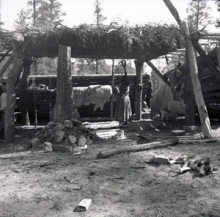Article
A brush shelter is a temporary dwelling made of branches, grass, and other plant materials. It is used primarily for sleeping or storage and has ties to many Native American tribes. Brush shelters often have open sides, and the main frame of the shelter is made of branches.
In Navajo culture, brush shelters can also be referred to as summer hogans, which are constructed when families follow sheep as they are moved to higher, cooler pastures during the summer. Brush shelters have also been called ramadas, although ramadas may also be constructed as more permanent structures than the typical brush shelter.
"Sheep camp with brush shelter, Fruitland, NM, 1952," photograph, ( 2006_20_409 Farmington Museum. All rights reserved. Use with permission only.
Manuscripts
References
Hill, W. W.
1938 Agricultural And Hunting Methods Of The Navaho Indians. New Haven: Yale
University Press.
Roberts, John M.
1951 Three Navaho Households: A Comparative Study in Small Group Culture. Reports of
the Ramah Project. Cambridge, Mass.: Published by the Museum.
Waldman, Carl
2009 Shelter, Types of structures. Atlas of the North American Indian, Third Edition. New
York: Facts On File, Inc.

